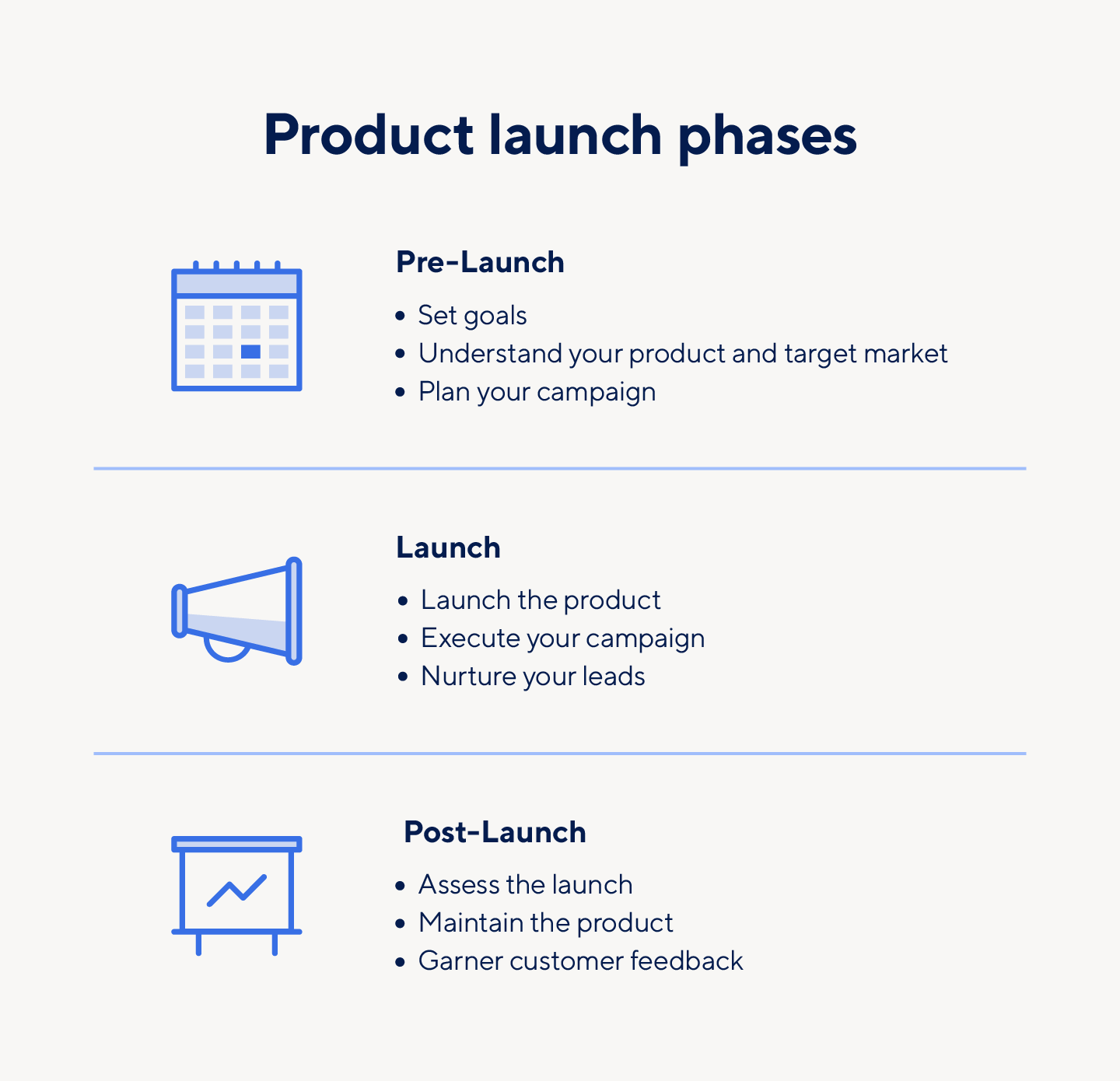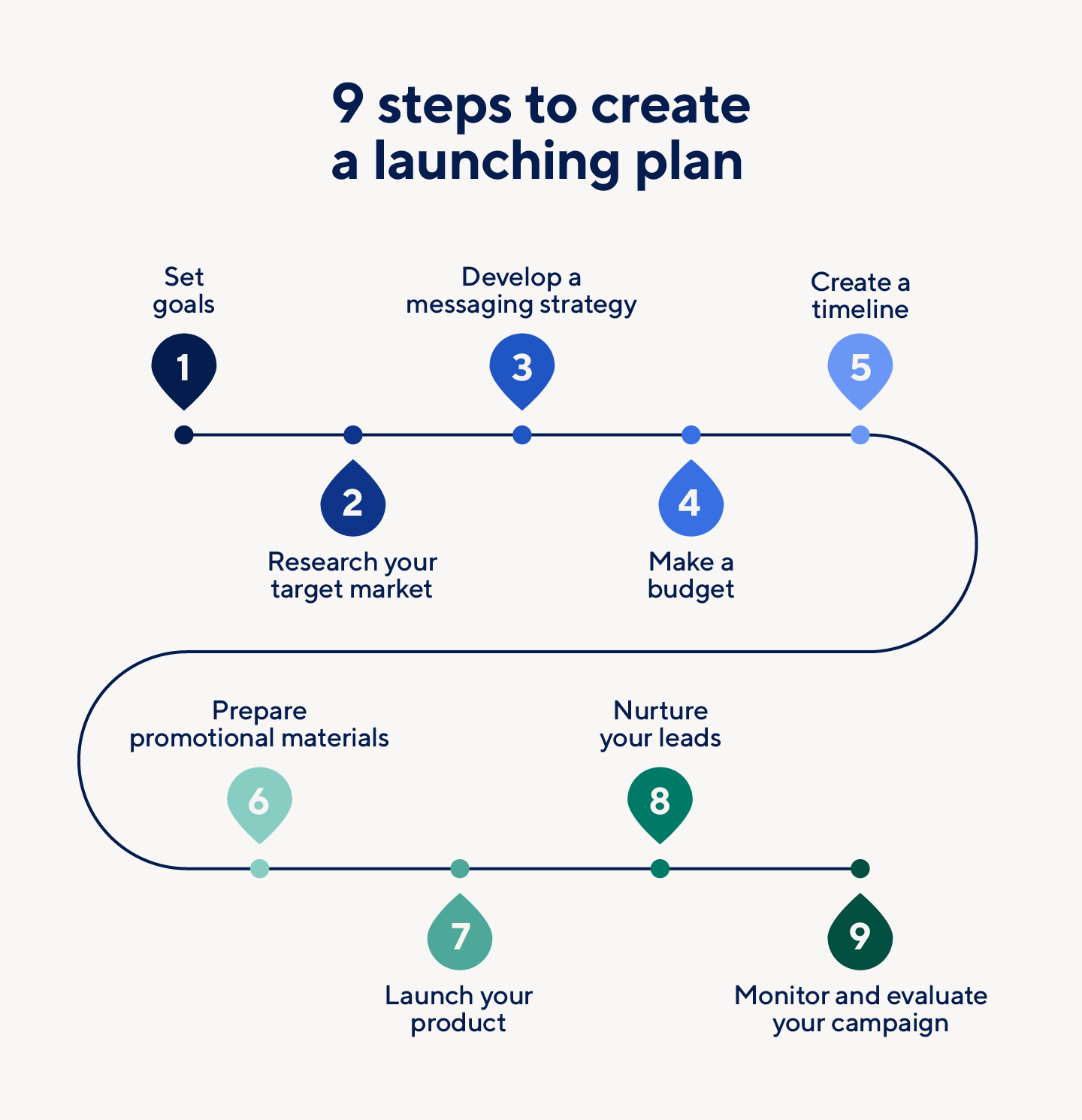What Is a Product Launch Plan?
A product launch plan is a detailed strategy that outlines the necessary steps and activities to successfully introduce a new product to the market. It typically includes a timeline, budget, marketing and advertising strategies, and sales goals.
The plan is designed to create excitement and anticipation for the new product, generate interest from potential customers, and ensure a smooth and successful launch. A well-executed product launch plan can do the following:
- Establish Clear Objectives: This ensures that everyone involved in the launch, from the marketing team to the sales team, is on the same page and is working toward the same goals.
- Improve Internal Communication: By providing a clear roadmap and timeline for the launch, you’ll ensure that everyone involved knows what they need to do and when.
- Increase Sales: By generating excitement around a product, building anticipation, and creating a sense of urgency, the launch can encourage customers to make a purchase and drive sales for your business.
Types of Product Launches
It's crucial to have a launching plan in place, but you also need to decide how extensive you want the actual launch to be.
Consider the following three types of product launches.
Soft Launch
A soft launch is a limited release of a product or service to a select group of customers or a specific geographic area to test and fine-tune the offering before a full-scale launch.
Businesses use this strategy to gauge customer response, identify potential issues or bugs, and make necessary adjustments before a wider release. Soft launches are typically done with a reduced marketing budget and a smaller team to minimize risks and gather valuable feedback from early adopters.
Minimal Launch
A minimal launch refers to the process of launching a new product with the bare minimum features, functionalities, and resources required to validate the product idea and gather feedback from early adopters. It involves launching a product only with essential features and without any additional bells and whistles that are not necessary for the core functionality of the product.
The goal of a minimal product launch is to test the product idea, gauge user interest, and refine the product based on customer feedback before investing more resources into its development. This approach is commonly used in Lean startup methodologies and can save startups time and money while ensuring they’re building a product that customers actually want.
Full-Scale Launch
A full-scale launch refers to the complete and official launch of a product, service, or project. It involves the deployment of all necessary resources, such as marketing, advertising, logistics, and technical support, to ensure a successful and impactful launch.
The purpose of a full-scale launch is to create maximum awareness, generate interest, and drive sales of the product or service. It’s typically the final stage of a comprehensive planning and execution process and is intended to deliver desired outcomes for the organization.
Product Launch Phases
A strong product launching plan involves many different steps, from developing the right messaging and assets to empowering sales staff and maintaining momentum.
A product launch comprises three phases: pre-launch, launch, and post-launch.
Phase 1: Pre-Launch
The pre-launch phase is the period before the official launch of a new product or service and is a crucial part of any launch. This is where you’ll do the majority of planning activities, including the following:
- Set achievable goals
- Become an expert on your product
- Understand the target market
- Develop a messaging strategy
- Create a timeline
- Make a budget
- Plan promotional materials
- Test your product
The duration of the pre-launch phase can vary depending on the product or service being launched, as well as the overall goals of the launch. However, a typical pre-launch can range from a few weeks to several months.
Overall, the pre-launch phase is a critical period that requires careful planning and execution to ensure a successful launch.
Phase 2: Launch
Simply put, the launch phase involves executing all of the planning you did during the pre-launch phase. This is when your product is finally out on the market.
This phase is much shorter than pre-launch. Depending on how long you believe you need, it may take a day or a week.
Phase 3: Post-Launch
Even once you launch your product, there is still work to do. In the post-launch phase, you'll conduct a review and compile feedback and data to determine what went well and what didn't.
Doing so will help you to manage or improve your product so that it remains relevant to your market and maintains customer retention.
How to Create a Product Launch Plan in 9 Steps
Now that you understand the different phases of a launch, it’s time to delve deeper into the specifics. Follow the nine steps below for a successful launch.
1. Set Goals
Phase: Pre-launch
The first thing you’ll want to do when developing your launching plan is establish the objectives of the product launch and determine desired outcomes. Think about what your product team hopes to achieve throughout the process.
Businesses often hope to achieve a variety of goals, including the following:
- Building product awareness
- Generating interest
- Capturing new customers
- Increasing sales
- Finding a product-market fit
- Establishing a strong market position
Once you’ve determined your goals, list out the key performance indicators (KPIs) for each goal so you know what to measure for success. Remember: Good goals are clear, measurable, and have an expected time frame, and the best way to achieve that is by writing SMART goals.
Pro tip: One of the easiest ways to get started setting and tracking your goals is to use a goal setting template that you can customize to suit your needs.
2. Do Your Research
Phase: Pre-launch
Another crucial step in your launching plan is to conduct in-depth research on your target market, competitors, and industry. You should have a thorough understanding of the space in order to create an effective strategy that’ll engage your audience and win their business.
Here are some things businesses typically research during a pre-launch phase:
- Market Demand: Conduct market research to determine if there is a need or demand for the product.
- Competitive Landscape: Research the competition to understand their offerings and identify opportunities for differentiation.
- Target Audience: Identify the target audience and research their needs, preferences, and pain points.
- Marketing Channels: Research the most effective marketing channels to reach your target audience and create a marketing plan.
- Product Features: Conduct user testing and research to ensure product features meet the needs of your target audience.
3. Develop a Messaging Strategy
Phase: Pre-launch
Now that you have a better understanding of the space, you need to create a marketing communication plan that defines how you will execute the product launch. This means developing a messaging strategy that will resonate with your target market while demonstrating the value of your product.
To do this, you’ll need to do the following:
- Define Your Value Proposition: What makes your product unique? What benefits does it offer that your competitors don't? Your value proposition should be front and center in your messaging strategy. Make sure you can clearly articulate what sets your product apart and why it's worth paying attention to.
- Craft Your Messaging Framework: Your messaging framework is a set of key messages you want to communicate to your audience. These messages should be concise, memorable, and aligned with your value proposition. Your messaging framework should guide all of your communications, from your website to your social media posts.
- Choose Your Channels: Where does your audience spend their time online? Which social media platforms do they use? Which publications do they read? Do they attend events? Choose the channels that will be most effective in reaching your target audience, and tailor your messaging accordingly.
4. Develop a Budget
Phase: Pre-launch
At this point, it’s time to develop a budget to ensure you’re managing costs and properly allocating resources.
First, you’ll need to determine the scope of your product launch. You can do this by making a list of all the activities required for the successful launch of your product. This can include product development, marketing and advertising, PR, events, promotions, etc.
Next, assign resources (people, time, and money) to each activity. Determine the number of people required for each activity and estimate the amount of time each task will take. Then, assign budgets for each activity.
Remember that every product launch is different, and the budgeting process will vary depending on the product, target audience, and market conditions.
Pro tip: Use these Excel budget templates to track and manage your business expenses so you can make the best strategic decisions for your launching plan.
5. Create a Timeline
Phase: Pre-launch
To ensure everything stays on track for the launch, you’ll need to create a project timeline. Start by setting the launch date for your product, as this will be the anchor point for your entire timeline.
Next, identify the key milestones or events that need to happen in order to launch the product successfully. This may include tasks such as product development, testing, marketing, and sales. Make sure you estimate the time frames for each milestone. This will give you a rough idea of how long each task will take and help you identify any potential roadblocks or delays.
Additionally, you’ll need to identify any dependencies between tasks. Some tasks may need to be completed before others can begin, so it's important to factor this into your timeline.
6. Prepare Promotional Materials
Phase: Pre-launch
Promotional materials are key to getting the word out and creating hype that gets people excited and talking about your product. This includes materials such as email newsletters, landing pages, videos, social media posts, and other assets, depending on what channels you plan to use.
You’ll need to develop marketing materials for different parts of your product launch such as the teaser, announcement, and promotional content.
The teaser is essentially a hint, clue, or sneak peak that creates anticipation and excitement for your new product. It’s designed to generate interest among the target audience, without revealing too much about the product itself.
Then there’s the actual announcement, which finally reveals what your new product is as well as any special features or benefits that may be of interest to the target audience.
After announcing your new product, you can engage your target market and attract more customers by sharing promotional content like a giveaway or release date discount.
7. Launch the Product
Phase: Launch
Once your launch date finally arrives, it’s time to launch your product. This day should be an event — literally. Host in-person or online events like webinars or a live social chat to connect with your customers.
During these events, you can show your customers live demos or invite influencers to try out your new product. You’ll also want to collaborate with your sales team to plan meetings and outreach the day of the launch to increase the momentum of your campaign.
8. Nurture Your Funnel
Phase: Launch
After your launch, you’ll have reached a lot of people, but that doesn’t necessarily mean you’ve landed a lot of sales. It often takes several touchpoints before someone is convinced to start moving through the sales funnel, so don’t lose your momentum.
Continue to nurture those leads with emails, free trials, demos, blogs, and other promotional materials.
9. Monitor and Evaluate
Phase: Post-launch
Depending on when your launch phase has ended (typically within a week of the launch date), this will bring you to the post-launch phase. This is the time when you track the success of the product launch and evaluate your marketing performance.
Spend some time analyzing your results. Here are a few questions to ask yourself:
- Did you meet the goals you made in the pre-launch phase? Why or why not?
- How did customers feel about your product? Were they satisfied or were there things they wished were different?
- Where did your campaign succeed and fail?
- Did you fail to anticipate something?
- Did you learn anything?
As a good marketing project management practice, you should record your successes and failures. This will allow you to reflect on what went well and what didn’t so you can make changes or pivot strategies for next time based on your desired outcomes.
Create a Successful Product Launch Plan with Smartsheet for Marketing
The best marketing teams know the importance of effective campaign management, consistent creative operations, and powerful event logistics -- and Smartsheet helps you deliver on all three so you can be more effective and achieve more.
The Smartsheet platform makes it easy to plan, capture, manage, and report on work from anywhere, helping your team be more effective and get more done. Report on key metrics and get real-time visibility into work as it happens with roll-up reports, dashboards, and automated workflows built to keep your team connected and informed.
When teams have clarity into the work getting done, there’s no telling how much more they can accomplish in the same amount of time. Try Smartsheet for free, today.


